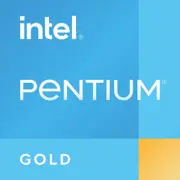Intel Pentium Gold G5400

Intel Pentium Gold G5400: Budget Processor for Basic Tasks in 2025
Overview of Capabilities, Compatibility, and Use Cases
Key Features: Coffee Lake in Miniature
The Intel Pentium Gold G5400 processor, released in 2018, remains relevant for budget builds due to its energy efficiency and affordable price (around $70 in 2025).
Architecture and Process Technology
- Codename: Coffee Lake (14 nm).
- Cores/Threads: 2 cores, 4 threads (Hyper-Threading).
- Cache: 4 MB L3.
- Base Frequency: 3.7 GHz (without Turbo Boost).
Despite the outdated 14nm process technology, the processor shows stable performance in office tasks and light applications. The integrated Intel UHD Graphics 610 supports 4K video (via HDMI 1.4) and basic gaming.
Performance
- Geekbench 6: 730 (single-core), 1508 (multi-core).
- Practical Examples:
- Watching YouTube in 4K: CPU load – 20-30%.
- CS:GO on low settings: 40-50 FPS (720p).
- Working in Microsoft Office: instant responsiveness.
Key Features: Support for virtualization (VT-x), hardware data encryption (AES-NI), power consumption below 60W.
Compatible Motherboards: LGA 1151v2 Socket
Motherboards with chipsets H310, B360, H370, Z370, Z390 are suitable for the Pentium G5400.
Selection Recommendations
- Budget Option: ASUS Prime H310M-K (around $60). Supports DDR4-2666, HDMI, USB 3.1.
- For Upgrading: MSI B360M Pro-VDH ($80-90). Includes M.2 for NVMe SSD and four RAM slots.
Important:
- LGA 1151v2 is not compatible with 8th-generation processors on older boards (e.g., H110).
- BIOS updates may be required for Z370/Z390 chipsets.
Memory: DDR4-2400 and Dual Channel Mode
- Memory Type: DDR4-2133/2400 (official support).
- Maximum Capacity: 64 GB (practically up to 32 GB due to budget motherboard limitations).
- Recommendations:
- 2×8 GB DDR4-2400 (for example, Kingston ValueRAM – $35 for a set).
- Avoid high-frequency modules (above 2666 MHz) as the processor does not utilize them.
Tip: Activate dual channel mode for a 10-15% performance boost in gaming.
Power Supply: Minimum 300 W
With a TDP of 58W, the processor does not require a powerful PSU:
- Without discrete graphics card: 300 W (e.g., EVGA 400W – $40).
- With a GTX 1650-level graphics card: 450 W (Corsair CX450 – $60).
Selection Criteria:
- 80 Plus Bronze certification.
- 4-pin CPU connector (some cheap PSUs may not have it).
Pros and Cons of the Pentium G5400
Advantages:
- Price: One of the most affordable processors with Hyper-Threading.
- Energy Efficiency: Suitable for compact PCs and HTPCs.
- UHD 610 Graphics: Can handle Netflix in 4K and older games.
Disadvantages:
- 2 Cores: Multitasking is limited (e.g., streaming + gaming is not feasible).
- No Overclocking: Fixed frequency.
- Outdated Platform: No support for PCIe 4.0 and DDR5.
Use Cases
1. Office and Study
- Example: Working with documents, Zoom conferences, browser (10+ tabs).
- Recommendations: Add an SSD (e.g., Kingston A400 240 GB – $25).
2. Multimedia
- Example: Mini-ITX media center (4K playback via Plex).
- Recommendations: Use passive cooling (Noctua NH-L9i).
3. Light Gaming
- Example: Dota 2, Minecraft, Overwatch (on low settings).
- Tip: Add a GTX 1050 Ti-level graphics card (used – $80).
Comparison with Competitors
AMD Athlon 3000G (Price: ~$65)
- Pros: Vega 3 graphics are more powerful than UHD 610.
- Cons: No Hyper-Threading, lower IPC.
Intel Celeron G5905 (Price: ~$50)
- Pros: Cheaper.
- Cons: 2 cores/2 threads, weaker multitasking.
Conclusion: The Pentium G5400 outperforms the Celeron due to Hyper-Threading but falls short against the Athlon in graphics.
Practical Building Tips
1. SSD is Essential: HDD will bottleneck this CPU.
2. Cooler: The stock cooler is sufficient, but for quiet operation, consider the Deepcool GAMMAXX 400 ($20).
3. Motherboard: Choose models with HDMI 2.0 if you need 4K@60Hz.
4. Upgrade: Later, you can install a Core i3-9100 (4 cores/4 threads), but it's better to consider the LGA 1200 platform right away.
Conclusion: Who is the Pentium G5400 Suitable for in 2025?
This processor is a choice for:
- Budget office PCs.
- Home media centers.
- Students needing a computer for educational purposes.
Why this one? Low price, sufficient performance for basic tasks, and minimal power consumption. However, for gaming or professional tasks, it’s better to add $50-100 and opt for the Ryzen 3 5300G or Core i3-12100.
Final Verdict: The Pentium G5400 is a "workhorse" for those not ready to overpay for excess power.
Basic
CPU Specifications
Memory Specifications
GPU Specifications
Miscellaneous
Benchmarks
Compared to Other CPU
Share in social media
Or Link To Us
<a href="https://cputronic.com/en/cpu/intel-pentium-gold-g5400" target="_blank">Intel Pentium Gold G5400</a>